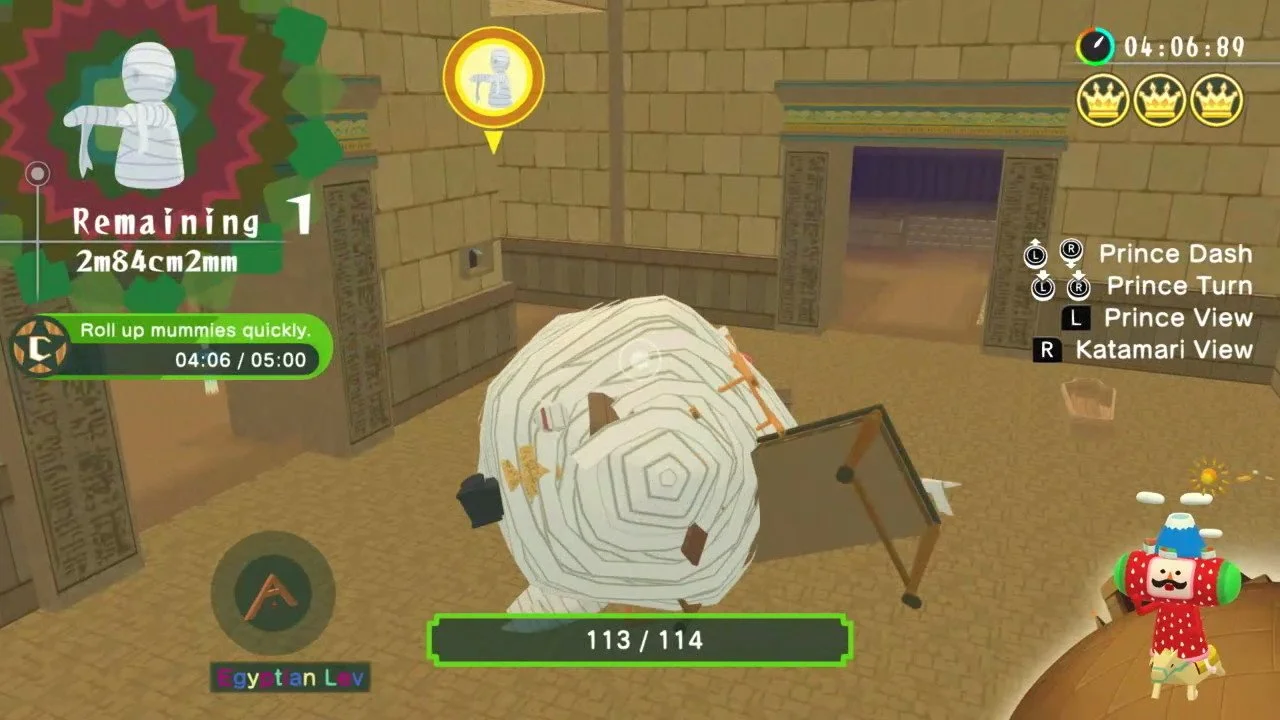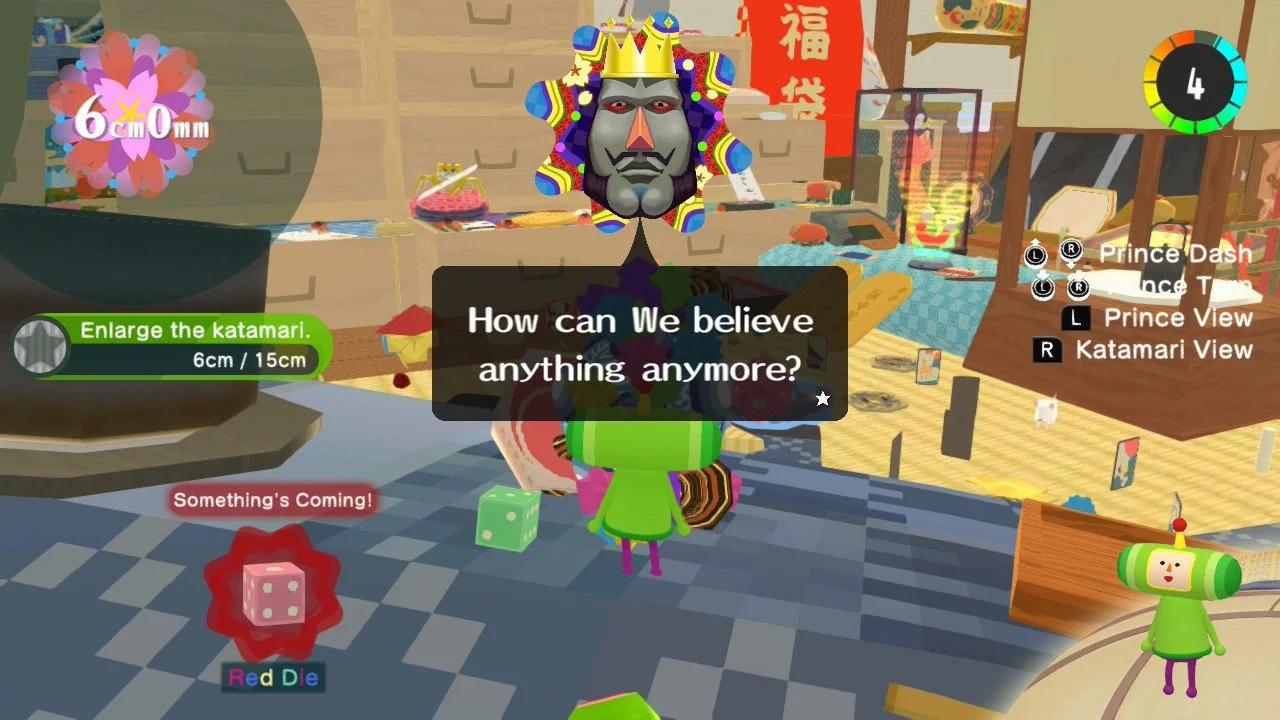Once Upon A Katamari Review (Switch 2) - The Prince Who Rolled Through Time
/Bandai Namco’s wacky series about rolling up everything in sight has finally dropped a new game after years of remakes, remasters, and mobile games. When I first saw the trailer, I was excited by the time-traveling gimmick that saw the Prince and his cousins globetrotting throughout a variety of time periods in what was sure to be the Katamari game with the most locales yet. It was only later when I was struck by how samey it all looked, as if the game’s low-poly, pastel-colored aesthetic and gameplay were given just minor facelifts and tweaks from past entries. But I’ve spent many happy hours rolling to my heart’s content, so I was eager to dive in.
Right off the bat, things feel both warmly familiar and oddly off. The story this time around has the King of All Cosmos accidentally obliterating much of time and space, so you’re tasked with traveling through time in the S.S. Prince spaceship and rolling up objects from various time periods so the universe can be rebuilt. It’s a fun conceit that makes for some cute storybook-like skits, mostly involving the Queen, and adds some much-needed variety to a series that has never truly grown past its central gimmick, nor does it aspire to.
Keep on rollin’, rollin’, rollin’...
For the uninitiated, a Katamari game is one of those love-it-or-hate-it experiences. It boasts an odd, unique presentation where you’ll be tasked with rolling up objects from smallest to largest and accomplishing side tasks to please the self-important and downright narcissistic King of All Cosmos, who, despite his bizarre fashion sense, is not a fun boss. He’ll zap you with eye lasers if you don’t make quota, insult you for failing to achieve a high enough rank, and constantly interrupt gameplay with floating text boxes taking up the middle of your screen (you can mash to dismiss them).
Gameplay-wise, Once Upon A Katamari’s got its predecessors’ arcade-style gimmick where you progress through a series of levels, tackling various challenges such as rolling things up within a certain time limit, rolling up specific objects, rolling up a specific number of things and aiming to be as big as possible, or simply greening a desert by rolling a giant sphere of water over it. Unlike previous games, there’s a wide variety of tasks to accomplish, and 3 crowns, a cousin, and a present to unlock not just in each level, but in each alternate challenge. One level in Ancient Greece has you rolling up certain philosophers, who drop famous quotes as you do so. I can’t think of one bad time period out of the bunch. Out of the ten locales available, all of the ones they picked are easily justifiable, with three or more levels each, and add a lot of charm and atmosphere to the game. My one wish is that they would release more long levels where you grow to be able to roll up entire continents, as those have always been my favorites. There’s only one level I’ve unlocked so far where you can grow to a ridiculous, country-spanning size.
The most important gameplay change is that there’s power-ups called Freebies now. There’s a clock-stopping Stopwatch that not only halts your timer, but freezes anything that’s moving around the map, a radar that shows you the locations of nearby crowns, cousins, or presents, a rocket boost that jets you around the map, and so on. The best item is the magnet that pulls in nearby objects. Clever and crucial timing of the magnet can often make or break a run, with it being all but necessary to achieve S-ranks. The power-ups change the game for the better and make collecting everything quite a bit easier, though I can see why some people find them to be a cheat.
I found it surprisingly fun to collect all 3 crowns in each level. It’s like an “I Spy” or “Where’s Waldo?” game at times. Certain special levels require you to find X amount of crowns, so they’re essential for progress. Thankfully the sonar/radar item helps you to pinpoint them, if you’re having a tough time. The King also grants you King Tokens for completing levels, and for besting certain challenges (such as rolling up 600 objects, etc.), which are clearly signposted outside each level. These tokens can be exchanged for new Expressions and other goodies.
KatamariBall makes for multiplayer mayhem
Another cool new addition is KatamariBall, a competitive mode that is playable in-game with CPUs, or online. It’s a mode where you go head-to-head with other players, rolling up objects before dropping them off at your UFO entrance, which sucks them up and makes you small again. Whoever has the most points after several minutes wins. Think Katamari meets Pikmin. You can keep rolling to your heart’s content, but cutting it close to the clock means risking being thwarted by your foes rolling you up. Yes, that’s right. Now you can live the dream of rolling up your opponents and totally throwing them off. It’s actually a viable strategy in this game - once rolled up, you’ll reset, but will have lost quite a bit of mass and time.
Unfortunately, the co-op mode from We <3 Katamari does not return, and while KatamariBall is a fun party mode, there’s sadly no local split-screen multiplayer.
Speaking of the cousins, you can customize them pretty thoroughly this time around. Various outfits, expressions, and hats make for tons of unique possible combinations. This is one of my favorite new features, as this spurred me on to complete as much of the game as possible, since you can unlock a lot of new stuff via presents and spending King Tokens.
The Katamari games are known for their exceptional soundtracks, and while some may disagree and miss the more eclectic, experimental mixes of the past, I feel that this time around they’ve nailed the tone by delivering a cozy playlist with good vibes all around. The slick soundtrack sets the merry mood, with everything ranging from big band covers to jazz arrangements, Japanese electronic pop, and even the San Francisco Boys’ Chorus singing a beautiful hymn. There are maybe one or two tracks that didn’t really work for me in a list of 22 main tracks. There are also 2 sets of DLC tracks (each one priced at about $15 and featuring 26 and 34 songs apiece, plus costumes) from previous Katamari games. While it’s too bad that they’re not included with the base release, I understand that licensing music costs money, so it’s nice to have the option nonetheless.
Like pushing an uneven rock through a swamp…
Now that we’ve talked about its good qualities, let’s rip the band-aid off. What’s off about Once Upon A Katamari is the physics. Looking online, I’m glad to see that I’m not the only Katamari fan who feels that the controls and physics seem off. On my Switch 2, the sticks seem to have huge dead zones that make precise movement very difficult. Your movement also sometimes slows to a crawl out of nowhere. Gone is the smooth-feeling rolling from titles like We <3 Katamari. It sometimes feels like you’re stuck using a couple of old arcade sticks to turn a sluggish boulder. Whether this is due to limitations of the game’s engine or a deliberate design choice, it feels jarring to those used to the level of precision the series once offered. It’s not that it’s impossible to be precise, just that it feels like it takes a lot of practice and finesse to achieve similar results.
Turning, on the other hand, is unilaterally terrible now. While you can quickly do an instant 180 by pushing a control stick in, spinning 45 degrees by holding one stick down and the other one up will sometimes take a long time. Why? I have no clue. Thankfully, at least boosting is easier now, as you can just hit ZL to jet forward. While you can still do it the old-fashioned way by rapidly moving both thumb-sticks up and down, there’s really no reason to do so. Climbing walls feels tougher than it’s ever been, requiring you to be lined up precisely and apply the exact amount of pressure on each stick. I also felt like it was a lot easier to bump into things this time around, and that there were more instances where I was unable to roll up something that should have been easy to absorb.
One wonders if all of this could be patched in a future update, or at the very least, that Bandai Namco would provide options for stick sensitivity. I would hope for a slider for both sensitivity (dead zones) and turning speed. It would alleviate my #1 issue with this game and make it a heck of a lot easier to recommend to new players. Longtime fans of the series will likely be able to eventually adjust and see great success, like I did, but I can’t imagine that someone just diving in for the first time will feel anything but frustration at not being able to make the often strict initial time limits while trying to adapt to often slow and sticky controls.
One of the best and most full-featured Katamari games ever
Depending on your skill level, one can probably beat everything Once Upon A Katamari has to offer in about 15 hours or less, and those hours will likely go by in a flash, but a large part of the fun lies in replaying each level to get the S-ranks, and even just redoing levels for the fun of it all. Like the best games in the series, the charm and music go a long way towards making for an experience you won’t want to put down until you’ve rolled up everything in sight.
At the budget price point of $39.99, it’s very easy for me to recommend Once Upon A Katamari to longtime series fans, as well as lapsed casual fans. If you can get past the sticky controls and a general sense of deja vu, the many time periods, customizable cousins, unique challenges, features, Freebies, and especially the zany multiplayer mode KatamariBall add a lot of replay value and make even a decades-old formula feel fresh again.
Verdict: 4 / 5 (Fantastic)
PROS
The many time periods make for a great variety in level design and challenges
Cousin customization lets you tailor your playable character
Unlockables and collectibles add a lot of replay value
KatamariBall delivers a fun competitive multiplayer mode, but only Online
CONS
Sticky and sometimes unresponsive controls can be sluggish and frustrating
Not enough levels where you get unreasonably large
No split-screen multiplayer
Could be a little longer
What I’ve Played
Beat the game at 10 hours, played for about 14 total (mostly single-player)
Beaten all main levels
Unlocked most of the cousins, presents, and expressions
*This review is based on a Switch 2 review copy provided to the reviewer
About the Author - Joseph Choi
Filipino-American gamer, professional shepherd and farmer, author, and filmmaker/videographer living in Central California. First consoles were the Game Boy and Sega Genesis, and I've been gaming since then, with a focus on Nintendo and Sony consoles.









SEGA and Ryu Ga Gotoku Studios put a ton of love and care into Yakuza Kiwami 2, and it runs flawlessly on Switch 2. If you’re like me and itching for a reason to take a plunge into the Yakuza universe, there’s no better time than the present.